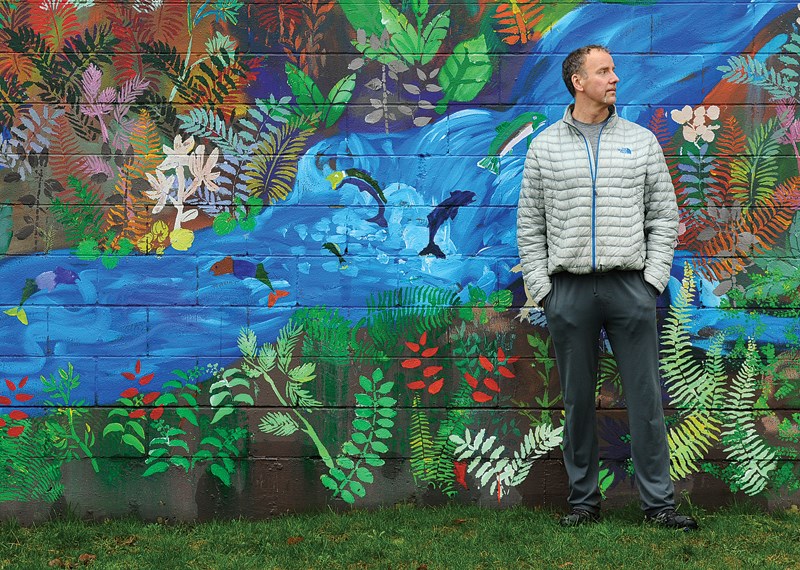The Mackay Creek Series and Wild New Territories book launch, North Vancouver City Library, third floor, Wednesday, March 22, 7 p.m. Registration required. For more information visit rondendaas.com.
The kids scurried from house to house, plucking sample-size packets of laundry soap from unwatched doorsteps before racing to Mackay Creek.
The eight-kilometre watershed was about to fall victim to the unlikely confluence of a detergent company’s campaign to increase its market share and a conspiracy concocted by the unnamed intelligence agency to which only children belong.
FOOOM!
Ten feet of foam rose like warm-brewed beer and flowed all the way to Burrard Inlet.
“I had always assumed that killed the creek,” recounts Ron den Daas.
Decades removed from the great detergent dumping, the artist has dedicated his work to resurrecting Mackay Creek.
While a pop psychologist might diagnose den Daas with a guilty conscience, the painter has likely atoned for whatever sentence he might have self-imposed over the childhood indiscretion.
Standing in a Heywood Park hatchery next to a giant tank teeming with chum fry, the artist and activist delves into The Mackay Creek Series, a book collecting 60 oil-on-birch portraits of the body of water.
While the creek stretches between Grouse Mountain and the inlet, den Daas elected to set up his easel in the same place 60 times.
At first glance there seems to be no difference between first glance and second glance.
Sometimes the view is dappled with summer light, sometimes it’s chrome with snow but it’s always the same view.
And then there’s a shadow showing under the water. A fallen tree shifts. A heron takes its perch and the gushing waterfall is reduced to a drip.
The paintings belie the lethargic cliché that defines insanity as repeating an action and expecting different results. Den Daas repeated the same action 60 times and got 60 different results.
“To me it’s different every day,” den Daas says of the creek.
The North Vancouver resident seems to subscribe to French artist Pierre-Auguste Renoir: that while your imagination can supply you with a few leaves, “nature offers you millions, all on the same tree.”
Beyond the painting, simply spending that much time by the creek was transformative, according to den Daas.
“By the time I would walk out of that space I felt as though I had been transported into this primordial, rainforest ecology from some other millennium,” he says.
Equipped with his brush, den Daas’ mandate was more or less the same as the sheriff in a western: he’s just trying to do the place justice.
“I never do,” he says with a laugh.
An introductory essay by Bill Jeffries describes The Mackay Creek Series as a “hydrological journal” intended to “sensitize” the viewer.
“These creeks are living, moving things,” den Daas explains. “We in fact are part of that system and we’re just incredibly out of touch with it.”
The book is an attempt to put people back in touch with their surroundings while engaging with the contemporary art world, he says.
“We’re trying to make it accessible to everybody.”
Accessibility, fragility and resilience are recurring themes for den Daas.
While the North Shore’s waterways are vulnerable, they’re far from beyond hope.
Discussing restoration work at Mackay Creek, den Daas enthuses about the run of pink salmon that followed the work.
“When you see these creatures and their battle for survival you have to stand back and respect that,” he says. “It was a really good indication that if we make this effort … nature will respond.”
And while nature responds to society’s actions, den Daas is a firm believer that society responds to art.
There’s an “intersection between understanding nature on a scientific level” and creating art that redefines how we live with nature, den Daas explains.
“That’s why education is so important because if you don’t understand what you’re trying to protect, it won’t happen.”
While the book launch is set for Wednesday, den Daas is equally excited about Thursday. At 6 p.m. in Heywood Park dozens of ecologically minded residents are set to release thousands of chum fry.
It’s a local initiative, but den Daas is hoping it will help shift a global mindset.
“We cannot protect our little region without protecting everywhere.”
As the interview winds down den Daas shows no signs of wearying, offering his assessment of the struggle to restore the creeks.
“We’re at the very beginning.”



